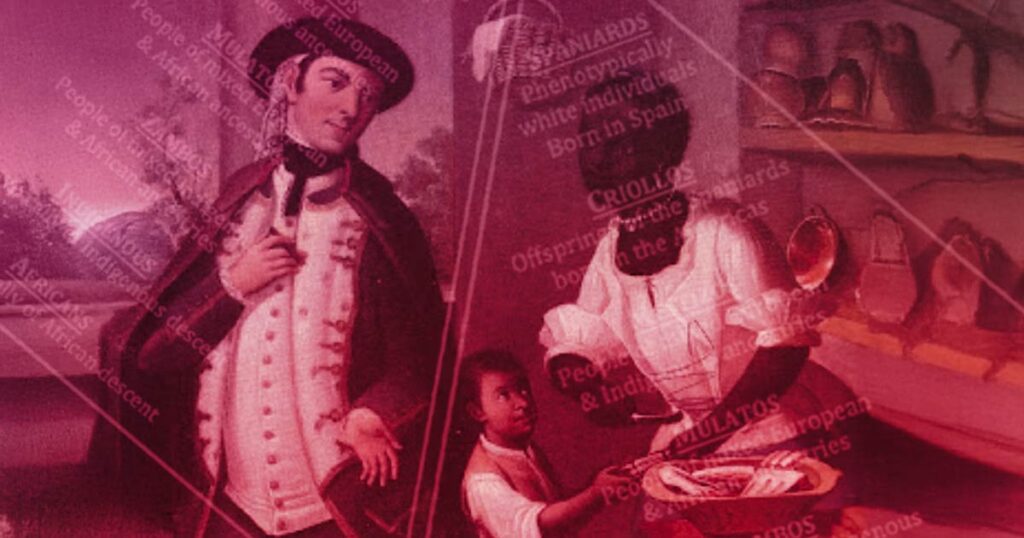
💡 The Casta System in Latin America
In Latin America, the Spanish created the Casta System to establish and maintain European dominance. It was a rigid racial hierarchy that categorized people based on their ancestry — from pure Spaniards to various mixed groups like Mestizos and Mulattos. These classifications dictated every aspect of a person’s life, from education and profession to legal rights. Paintings, laws, and taxes reinforced these divisions (Guzauskyte; Twinam; Liebsohn & Mundy).
The Casta system in colonial Latin America was a deeply hierarchical racial classification system imposed by the Spanish colonial authorities. It organized individuals into rigid social categories based on their ancestry—specifically, their mix of European, Indigenous, and African blood. At the top were Spaniards born in Europe (Peninsulares) and those born in the Americas (Criollos), followed by mixed-race individuals like Mestizos (European and Indigenous), Mulattos (European and African), and numerous other subcategories. At the bottom were enslaved Africans and Indigenous peoples.
This system wasn’t just social—it had legal and economic consequences. Your Casta label determined your access to education, property, professions, and even clothing. It was documented in baptism records, marriage documents, and censuses. Over time, the lines blurred as populations mixed further, but the legacy of racial stratification still echoes in many parts of Latin America today.
🇮🇳 The Colonial Construction of “Caste” in India
As J Sai Deepak outlines in his Indian Express article, something strikingly similar happened in India. While India had complex social structures for centuries, the concept of “caste” as a rigid, birth-based hierarchy was largely systematized during the European colonial period.
Nicholas Dirks, in his seminal work Castes of Mind (2001), traces the colonial origin of caste classification. He notes that the Portuguese were the first Europeans to use the term “casta” in reference to Indian society — borrowing the same racial language they used in their American colonies. The British and European missionaries built upon this, formalizing India’s social diversity into fixed caste categories that served colonial governance.
Christian missionaries like Bartholomeus Ziegenbalg and Abbé Dubois played a major role in this process. Ziegenbalg’s writings and the Tranquebar Mission’s ethnographic efforts framed South Indian religions and social orders in terms that aligned with Christian worldviews. Meanwhile, Dubois’ influential writings on Indian customs were directly used by British administrators to understand and manage Indian society (Dirks; Indian Express).
🧠 Colonial Categorization: The Shared Legacy
In both Latin America and India, European colonial powers simplified and racialized diverse societies using classification systems that fit their political and religious goals.
- In Latin America, this meant mapping people through visible racial mixtures and ancestry.
- In India, this meant translating local and fluid jatis into a rigid four-fold caste system — an attempt to define and control a vast, complex society through Western racial frameworks.
What emerged in both cases was a lasting colonial legacy that still shapes social divisions today — whether it’s caste-based discrimination in India or colorism and class divides in Latin America.
✊🏽 Why This Matters Today
Understanding the colonial roots of caste and racial systems is crucial for dismantling them. These were not ancient truths but modern constructs imposed by colonial powers to divide, control, and rule. Recognizing this shared history across continents like Latin America and India helps us connect global struggles against structural inequality, racial bias, and social injustice.
The task now? Decolonizing identity — by reclaiming the narratives, breaking out of imposed hierarchies, and building inclusive futures rooted in dignity, not division.
📚 Key Sources:
- Nicholas B. Dirks, Castes of Mind: Colonialism and the Making of Modern India (2001)
- J Sai Deepak, “How missionary work in Bharat birthed caste and Dravidian identity”, The Indian Express (2024)
- Tatiana Seijas, “The Casta System” – Voices From Latin America (Wooster College)
- Twinam, Ann. Purchasing Whiteness: Pardos, Mulattos, and the Quest for Social Mobility in the Spanish Indies
- Dana Leibsohn & Barbara Mundy, Casta Painting in Colonial Mexico – Vistas: Visual Culture in Spanish America
- The Casta System – Wooster Voices

